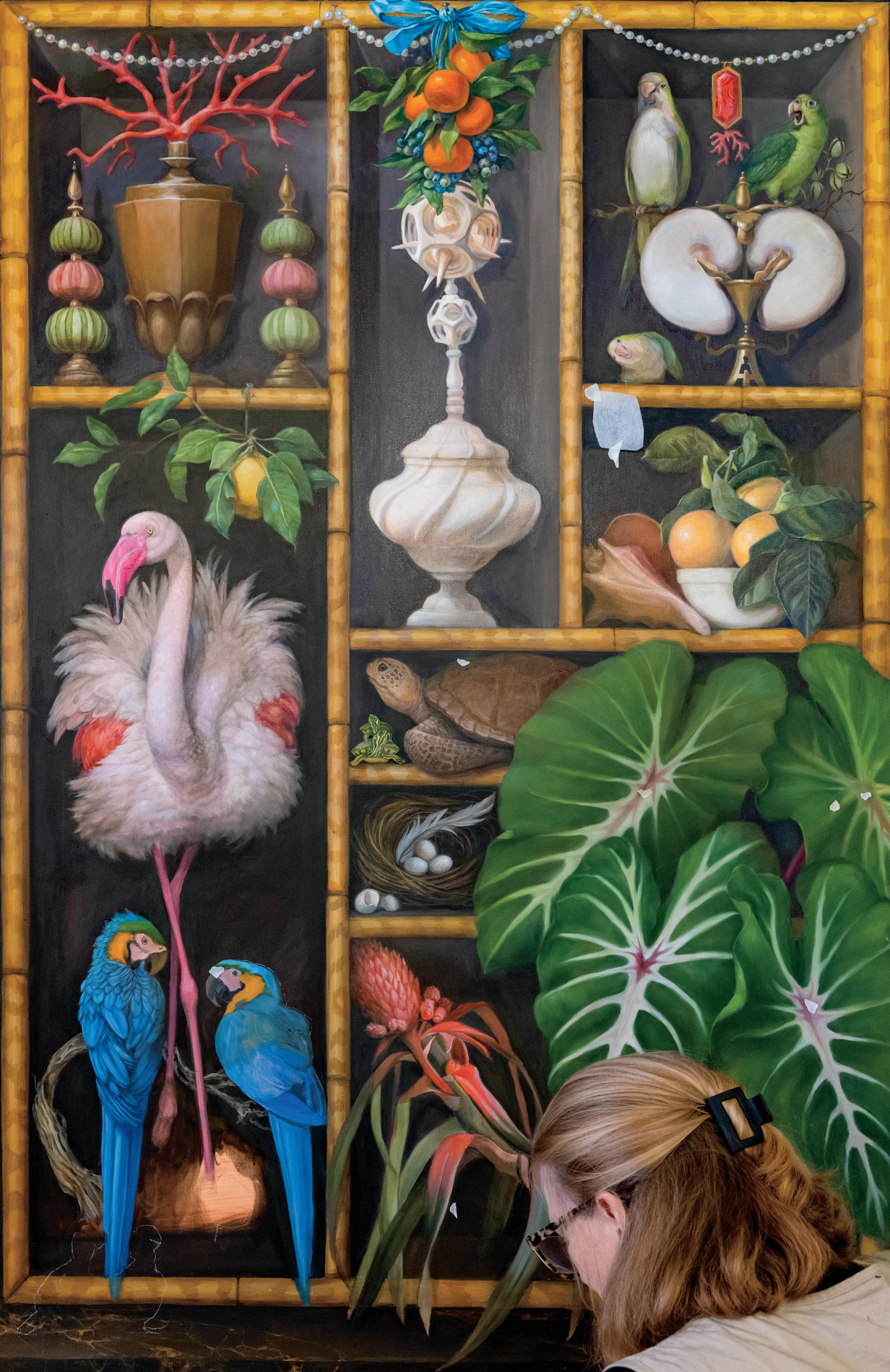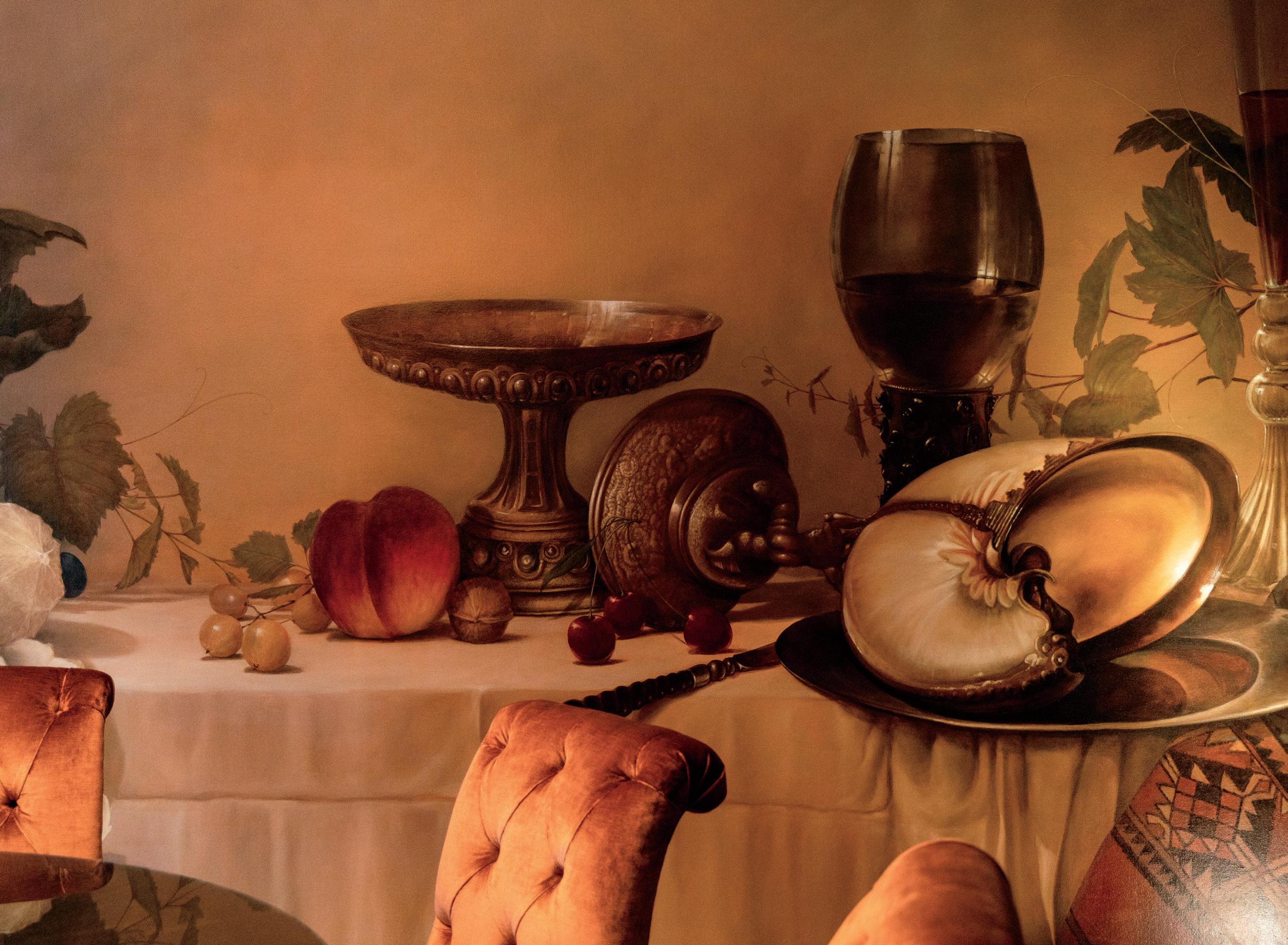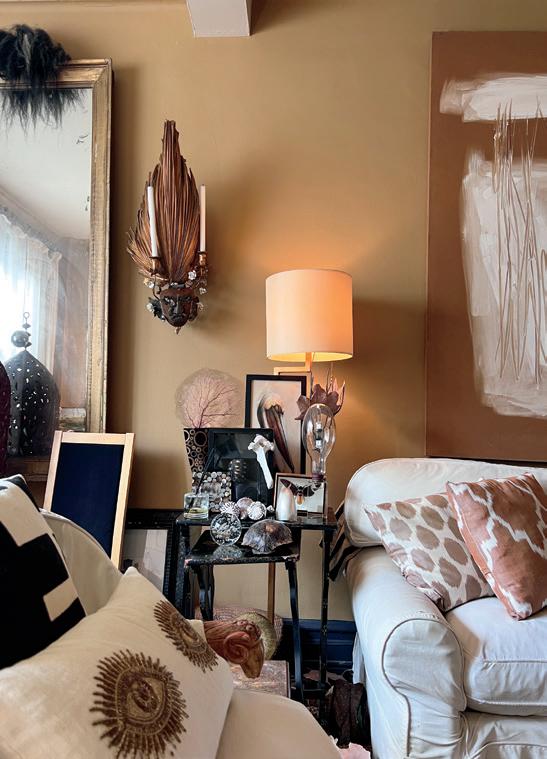
 A rough mock-up of flamingos for a mural in a Miami Art Deco home.
Covers: Anne’s love of nature shimmers in her maquette for a stylized and stylish mural.
A rough mock-up of flamingos for a mural in a Miami Art Deco home.
Covers: Anne’s love of nature shimmers in her maquette for a stylized and stylish mural.
 The ever-ebullient Anne Harris.
The ever-ebullient Anne Harris.
 Putting the final touches on one of a pair of cabinet-of-curiosity panels for a house in the Bahamas.
Putting the final touches on one of a pair of cabinet-of-curiosity panels for a house in the Bahamas.
Walls are functional brilliance—they support the roof over our head and enclose us in comfort and safety, yet for New York-based artist Anne Harris, that’s only the beginning. To this accomplished muralist, walls are fantastical fodder—a canvas for beauty and imagination, as well as her extraordinary talent. Though she can, and has, painted most anything (need a reproduction Picasso to stand in for the one your gallery has lent to a museum? Call Anne, as many a Manhattan dealer or art collector has done), murals have been her specialty for the last three decades. She loves bringing an idea, initially presented to her client in a small maquette, to 360-degree, largescale, spectacular life, and absolutely transforming an interior as she does so.
Design icons like Charlotte Moss turn to Anne when they need a glorious English countryside vignette to grace the foyer of a Park Avenue apartment or a pair of cabinet-of-curiosity panels for a Lyford Cay residence. Anne’s super-scaled rendition of a 17th-century Dutch still life, with its rich moody hues and glints

of silver and glass, embraces an elegant New York City dining room, but, ever versatile, she’s equally artful when a client requests a snarling Tyrannosaurus for an unexpected powder room. From Old World murals like those she loved when visiting the Vatican and Pompeii to more modern, exotic works, like the award-winning black and gold murals in the vein of French artist Armand-Albert Rateau that Anne painted for a private club in Chicago, her work is as wide ranging as her insatiable curiosity and joie de vivre.
“Anne has an aura—magnetism and charisma radiate from her. Her laugh is irrepressible and irresistible,” says her niece, Urban Electric’s own Halle Kern, whose solo trips to visit Anne were highlights of her teenage years and remain a special delight. Halle’s childhood visits to Anne’s New York City apartment left an indelible impression. It was a space “exuding personality” and filled with photography, art, sculpture, shells, textiles, and where Anne raised her own children as a single mother following her husband’s untimely death. “She opened me up to the creative world and continues to spark
my imagination with her appreciation for finding beauty in everything—from her highly unexpected fascination with bird legs and statues of feet to her full embrace of the art world, high and low,” Halle adds. “For all her visits to the Met and the Frick, she also helps sustain street artists by purchasing their work and supports aspiring artists with apprenticeships.”
Those apprentices learn the specialized skills that mural painting demands, an interesting hybrid of creativity and technical acuity. Anne typically paints in the studio on as many canvases as are required, which are then installed on-site by wallpaper hangers under her supervision. Despite being math-averse, she has an uncanny knack for scaling a work up to any dimension, some as large as 80 feet and spanning four walls. In the tradition of the Old Masters, Anne often starts with an underpainting of burnt sienna, a mid-tone base that lends depth to subsequent applications of paint and glaze, then layers on with her own sublime and signature magic. Brushstroke by brushstroke, glaze after glaze, walls do more than enclose space. They become portals to wonder.
A concept panorama in miniature depicting flora and fauna inspired by the work of Armand-Albert Rateau.MURALIST ANNE HARRIS OFFERS A MASTER CLASS IN THINKING INSIDE THE BOX AND ENTERING ANOTHER WORLD.

The earliest I can recall painting is around the age of eight. My mother recognized my budding artistic sensibility and signed me up for Saturday morning classes with Jack Clifton, a Virginia artist known as much for teaching as for his paintings. (His book, The Eye of the Artist, was reprinted four times.) Every week, we had just a few hours to complete a painting of a still life or an image in a postcard. It was great training for capturing a variety of subjects. I just loved it and continued with his classes for five years.
In many ways, you could call artists stylists, in the sense that we are always considering how to compose elements. I think this is what my mother detected in me, the clues to my future as an artist. She realized very early that there was only one side of my brain that worked! We lived in a rural area on the shore of the Chesapeake Bay, so there was not a lot to do in the traditional sense. My childhood was spent primarily in nature, looking and absorbing and collecting. I would bring back shells and bones and rocks to my girl cave under a fig tree and then experiment with composition.
Even though I studied painting, I wasn’t sure how I was going to make a living as an artist. My first jobs were in visual fields, at an auction house and a magazine, but they




 Anne working out a composition in her studio, toggling between tracing and painting freehand.
Below, from left: Scraps of images and textiles pinned up for inspiration and reference; a pair of Bolga fans from Ghana hangs from shelves of art supplies.
AS TOLD TO THE URBAN ELECTRIC CO.
Anne working out a composition in her studio, toggling between tracing and painting freehand.
Below, from left: Scraps of images and textiles pinned up for inspiration and reference; a pair of Bolga fans from Ghana hangs from shelves of art supplies.
AS TOLD TO THE URBAN ELECTRIC CO.
required a fair amount of writing and paperwork, two things I discovered I had no talent for. Luckily in the ‘80s, faux finishes were all the rage, so there was painting work to be had. But I came to understand the expression “eyes glazing over” after glazing one too many faux-finished walls. I knew I had to branch out and suggested to a friend a Rousseau-ish mural for his dining room and that kickstarted my 35-year career as a muralist.
In hindsight, murals have given me the freedom to explore artistic visions from around the world, and in that pursuit, the direction of my projects often veers drastically from one to the next, which may be considered a misstep for most artists. For me, this approach wards off boredom but also can ignite almighty fear. Each new commission challenges me with an endless variety of color, scale, subject. I wish I could lure more artists into this line of work. It’s diverse and stimulating and enormously satisfying. And you can make a living!
I, like many artists, found my first trip to Italy to be an utterly transformative experience. Of course I had seen and studied images of frescoes in books, but going into a room by Tiepolo and being surrounded by his murals—seeing the ceiling burst out and open—I was transfixed. It changed my life.



Obviously nothing beats seeing something in person, but since that’s often not possible I also rely on images I’ve been collecting for 40 years. I used to lean heavily on books because, back then, that was essentially the only source. The better your library, the better artist you were, so I had quite a collection. While I still turn to books, I also have some 60,000 photos, and counting, on my iPhone, though the filing is questionable!
“ IN HINDSIGHT, MURALS HAVE GIVEN ME THE FREEDOM TO EXPLORE ARTISTIC VISIONS FROM AROUND THE WORLD, AND IN THAT PURSUIT, THE DIRECTION OF MY PROJECTS OFTEN VEERS DRASTICALLY FROM ONE TO THE NEXT, WHICH MAY BE CONSIDERED A MISSTEP FOR MOST ARTISTS. FOR ME, THIS APPROACH WARDS OFF BOREDOM BUT ALSO CAN IGNITE ALMIGHTY FEAR. ”

 A glowing mural wrapping a dining room in New York explores and explodes in scale the traditional elements of still life paintings from the Dutch Golden Age.
A glowing mural wrapping a dining room in New York explores and explodes in scale the traditional elements of still life paintings from the Dutch Golden Age.
I find inspiration absolutely everywhere, so I’m constantly taking pictures of everything from an exhibition of Mughal paintings to water patterns in the shallows, to the progression of a blooming and fading peony. I’m lucky to live near the Metropolitan Museum and Central Park, where I walk almost every day. Each in its own way is a treasure trove. And I love going to the flower market and the botanical gardens. I may live in New York City, but nature will always be a very powerful draw.
For me, murals are the ultimate way to explore composition. Not only are you contending with imagery, but you are working out how to treat each wall of a room, dealing with cornices and moldings and doorways and directional light from windows. The color of the trim is also critical—it can make a mural shine or absolutely kill it, so I always try and weigh in on colors for all of the room’s details—the ceiling, the baseboards, even the light switches which I often paint to blend into the scene.




Sometimes people are fearful that a mural will overpower a room. True, they can be all-encompassing, but I see my work as more of a background. When done well, a mural should recede, but it still has a remarkable power distinct from a painting. A mural offers a fabulous way to step into another world. The possibilities for fantasy are endless.
 Halle with her Aunt Anne.
Anne’s apartment brims with finds reflecting her passion for art, nature and the talents of other makers.
Halle with her Aunt Anne.
Anne’s apartment brims with finds reflecting her passion for art, nature and the talents of other makers.


